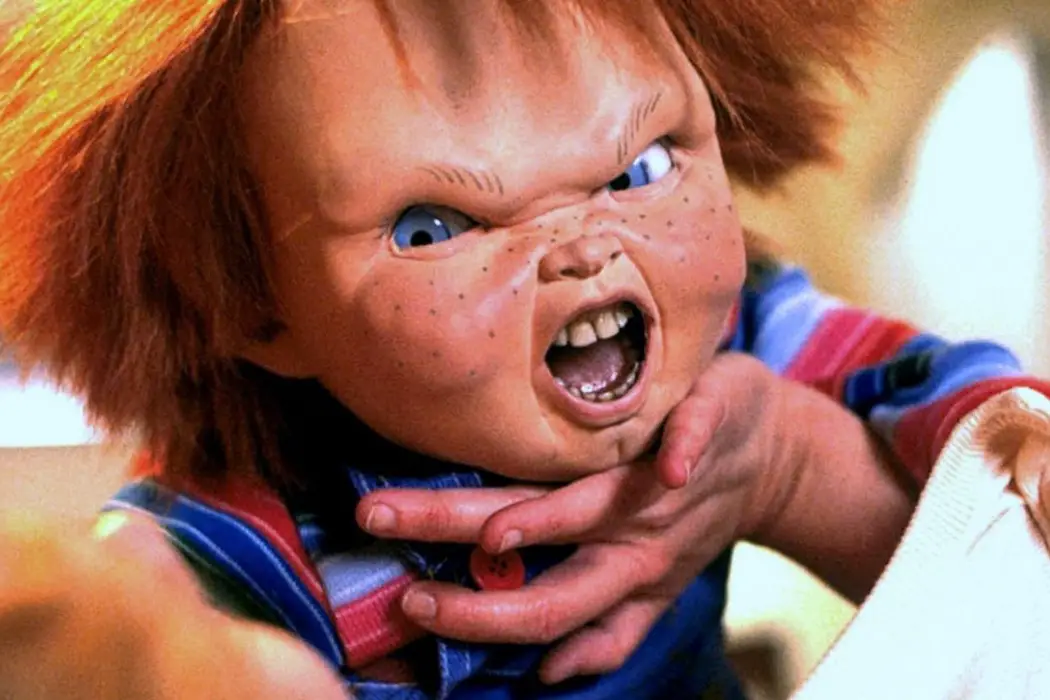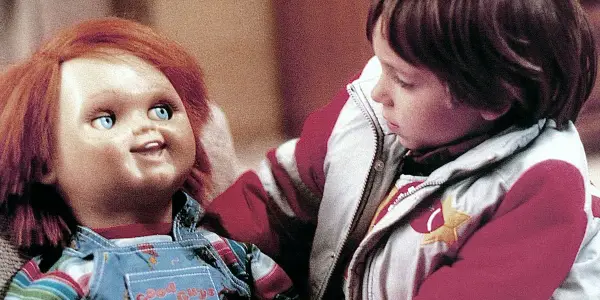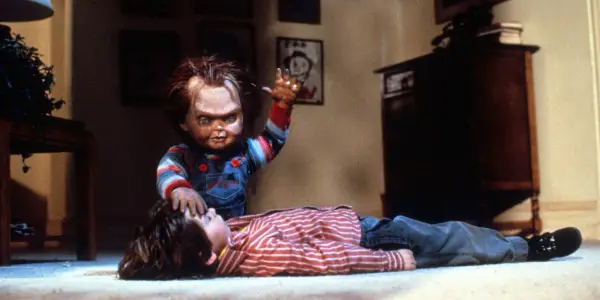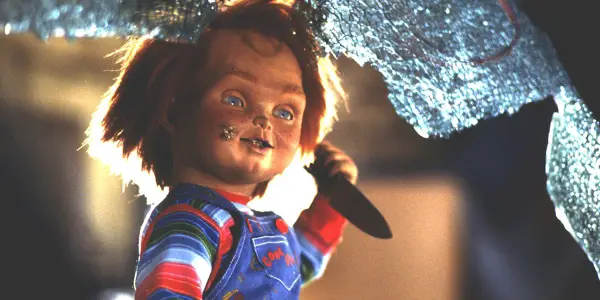Horrific Inquiry: CHILD’S PLAY (1988)

Stephanie Archer is 39 year old film fanatic living in…
Welcome back to the scariest, and at times goriest, column here at Film Inquiry: Horrific Inquiry. Twice a month, I will be tackling all things horror, bringing two films back into the spotlight to terrify and frighten once more. And occasionally looking at those that could have pushed the envelope further. Join us as we dive deep into the heart of horror, but warning, there will be spoilers.
“Well John it’s been fun but I got to go. I have a date with a 6 year old boy and you have a date with death!” – Chucky, Child’s Play (1988)
When I was a kid, I had an irrational fear that when I laid in bed at night, Chucky would be waiting with a knife to stab me. While it was the sequel, Child’s Play 2, that invoked this absurd terror, the fear made the memory of a terrorizing doll one I would not easily forget. And as Horrific Inquiry enters another year, the first big film of 2023 was not only a horror but a horror surrounding the terror of a doll. With memories of my childhood fear drawn out of the recesses of my mind by the release of M3gan, it seemed the perfect time to revisit everyone’s favorite Good Guy.
Child’s Play has proved itself to be an undeniable franchise. What started out as a terrorizing murderous doll turned into a sequel, a marriage, a family, and a cult – not to forget a documentary, a remake and a TV series, the latter having just released its latest season. Where other franchises have fizzled, finding both success and failure in their resurrections, Chucky has never ceased to exist. Yet, as much of a transformative existence as it has been, every moment has drawn off the success of the original.
Child’s Play stands as the king of the dolls, this sub-genre of horror bringing in its wake Annabelle, M3gan, and The Boy. And while Child’s Play was not the first horror film about dolls, The Great Garbo and Dead of Night its predecessors, it was the most successful.
Opening
Child’s Play opens in the middle of a cat-and-mouse game between Charles Lee Ray (Brad Dourif) and Detective Mike Norris (Chris Sarandon, The Princess Bride). As Lee Ray attempts to escape his pursuit, audiences watch as he is both wounded and his getaway driver Eddie (Neil Giuntoli) leaves him behind. What is immediately intriguing by this opening is how nonhorror it feels. The lighting and construction of the scene speaks to familiar crime films, its dark and gritty composition breaking the tropes of traditional horror. As Charles Lee Ray is moments from capture and succumbing to his wounds, he makes his way to a toy store.

There is a transitional feel as the toy store comes into view and Lee Ray making his way inside, the colors, however dulled by the continued low lighting, cutting through the traditional crime tropes. From the moment he walks in, the camera frames a stack of Good Guy dolls one on top of another, their uniformity an image the film will shortly shatter. As we move from a setting of crime to the fantastical, Child’s Play brings a sense of narrative plausibility to the ritual Lee Ray performs, transferring his soul into one of the Good Guy dolls. And while the imagination and fantasy speaks to the innocence and possibility of childhood, Lee Ray corrupts this idea, his ritual not only transferring him into the doll, but exploding the toy store.
The opening of Child’s Play is a display of immediate action and disarray, shattering convention and expectation of the horror genre. As the uniformity of the Good Guys is shattered by Lee Ray, so too is the idea of the film as strict horror, especially in a post-examination of its sequels.
Making the Good Guys
Following the explosion of the toy store, and the presumed death of Charles Lee Ray, Child’s Play introduces us to two-year-old Andy (Alex Vincent), immersed within the world of Good Guys. From TV to clothing. Andy is shown wearing the same clothes as his beloved Good Guys, speaking not only to his willingness to accept anything Good Guys related, but opening up the belief and innocence of a child. Dressed as a Good Guy, and subsequently the same as Chucky, Andy becomes his complete opposite from the very moment he is shown on screen. And where the opening embraced the action, here Child’s Play works to establish both the characters of mother Karen (Catherine Hicks) and Andy, as well as the relationship between them.

The film progresses to Andy’s want of a Good Guy doll and the mother’s by chance luck of acquiring one. As an audience, we already know that this Good Guy is far from it, that this particular doll is the catalyst for horror and destruction. As Andy is given the doll, him immediately removing it from the box, the idea that this Good Guy doll is different is immediately reinforced visually, the doll’s hair in disarray from the uniformity we had witnessed earlier.
A Dual Viewer Experience
And it is this audience knowledge that gives Child’s Play a duality within its viewing experience. Where many horror films bask in the “unknown”, the first person perspective leaves uncertainty and mystery as it does in Friday the 13th, Child’s Play invites its audience to know who the killer is. To know that, when we see scenes play out from a child’s perspective, it is not Andy’s viewpoint we are experiencing.
And while many can speak to the desensitization and spoilers over the decades since its release, the film is aware of the information it is giving – allowing its audience to be aware of Chucky, in many cases more than Andy. Early on, Andy is shown brushing his teeth. The film works between medium shots of Andy in front of the mirror and shots giving first perspective as Chucky makes his way to the living room for the 9 o’clock news. This first-person perspective is repeated shortly after, Chucky leaves the bedroom to kill Maggie (Dinah Manoff) for not allowing him to watch said news. Even as a blurred Chucky is shown running in the background, we know it is not Andy – no two-year-old can run that fast. Any remaining doubts that linger are quickly snuffed out as Andy is shown later on speaking to Chucky, the flour from Maggie’s crime scene clearly shown on the bottoms of his shoes – an element Andy points out in the next shot.

We may not see the doll come to life, but we know it is Chucky as we see what he sees. With this dual viewing experience, audiences are able to see a deeper horror within the film as we watch Andy attempt to bridge the gap between both childhood and adulthood. Andy is willing to accept the coming-to-life aspect of Chucky through the power of imagination and youth. Yet, he is able to understand the real world a much as fantasy. He tells Chucky ” I told you she would get mad” after Chucky attempts to watch the news segment. As the murders escalate following the explosive death of Eddie, we watch Andy plead to be heard – to be believed. He tries to make the adults around him see the fantastical world he is immersed within and what was once imitation, now has become reality. Andy attempts to bridge the gap between childhood and adulthood to no avail – and almost at the cost of his life. The scene in the mental hospital where Andy screams that Chucky is coming from him, visually watching him ascending the stairs outside, is heartbreaking and horrifying. We as viewers know help is not on its way, no one believes Andy.
It is not until the batteries fall out of the box that this gap is closed. That the two worlds are merged into a shared reality. And as Karen has come to believe, the detective lagging shortly behind, she too becomes as silenced as her son, the film muting dialogue as she attempts to find the man that sold her the doll – as she struggles to obtain the answers to save her son.
Conclusion:
For much of Child’s Play, seeing is believing. Where Andy commits to the belief Chucky is alive immediately, each adult character needs to be forced into their belief – either through proof or violence. And violence Child’s Play has. While not entirely gory, the doll’s destruction the most graphic, it does not lean away from the violence he causes.
As Child’s Play would help to close out a decade of slashers, it would open an unyielding franchise that would garner accolades of all ages, sequels that never fear the camp and create an unsatisfied need for more.
Watch Child’s Play
Does content like this matter to you?
Become a Member and support film journalism. Unlock access to all of Film Inquiry`s great articles. Join a community of like-minded readers who are passionate about cinema - get access to our private members Network, give back to independent filmmakers, and more.













